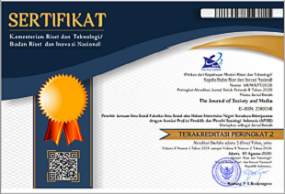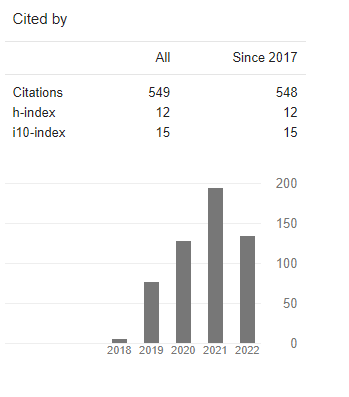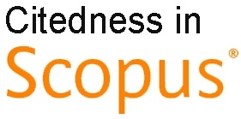On The Connection between Using Internet Usage and the Development of Negative Behavior among Malaysian Youth
DOI:
https://doi.org/10.26740/jsm.v7n2.p313-340Keywords:
gratification of using internet, malaysian youths, alcohol and drug consumption, internet usage, university studentAbstract
The Internet impacts students' lives and career paths. Excessive use may correlate with tobacco and alcohol consumption despite its benefits. The present study aimed to identify the relationship between gratification of Internet usage, problems in Internet usage, alcohol consumption, and drug abuse among Malaysian youth. The quantitative method was applied by using a survey questionnaire. A total of 440 students from the University Putra Malaysia (32.3% males, 67.7% females) were selected using a stratified random sampling method. The majority of the respondents (93.2%) were single. The students ranged from 23 to 40, with the majority of the younger group (78.3%) in the age range of 18-23. No link was found between Internet use gratification and alcohol/drug usage. No correlation was found between the Internet, alcohol, and drug problems. The association between age and alcohol usage was not significant. However, this relationship for drug abuse was substantial and positive. No significant differences were found in the mean values for the respondents' fields of study and alcohol or drug usage. The findings of the independent t-test illustrated that there were significant differences between marital status and alcohol consumption. Still, there were no significant mean differences between marital status and drug usage.
References
Adibah, N., Page, S., Heide, D., & Emery, S. (2021). Smoking in Movies: 2020.
Alcohol Rehab. (2019). Alcoholism in Malaysia. Retrieved from https://alcoholrehab.com/alcoholism/alcoholism-in-malaysia/
Alhassan, M. D., Kolog, E. A., & Boateng, R. (2020). Effect of gratification on user attitude and continuance use of mobile payment services: a developing country context. Journal of Systems and Information Technology.
Anderson, P., Bruijn, A. d., Angus, K., Gordon, R., & Hastings, G. (2008). Impact of Alcohol Advertising and Media Exposure on Adolescent Alcohol Use: A Systematic Review of Longitudinal Studies. Alcohol and Alcoholism, 44(3), pp. 229-243.
Babor, T. F., Robaina, K., Noel, J. K., & Ritson, E. B. (2017). Vulnerability to alcohol?related problems: a policy brief with implications for the regulation of alcohol marketing. Addiction, 112, 94-101.
Bonar, E. E., Schneeberger, D. M., Bourque, C., Bauermeister, J. A., Young, S. D., Blow, F. C., . . . Walton, M. A. (2020). Social media interventions for risky drinking among adolescents and emerging adults: protocol for a randomized controlled trial. JMIR research protocols, 9(5), e16688.
Bonomo, Y., Coffey, C., & Wolfe, R. (2001). Adverse outcomes of alcohol use in adolescents. Addiction, 96(1485), 96.
Boyle, S. C., LaBrie, J. W., Froidevaux, N. M., & Witkovic, Y. D. (2016). Different digital paths to the keg? How exposure to peers' alcohol-related social media content influences drinking among male and female first-year college students. Addictive behaviors, 57, 21-29.
Brewer, N. T. (2003). The Relation of Internet Searching to Club Drug Knowledge and Attitudes. Psychology & Health Publication, 18(3), 387-401.
Brunborg, G. S., & Andreas, J. B. (2019). Increase in time spent on social media is associated with modest increase in depression, conduct problems, and episodic heavy drinking. Journal of Adolescence, 74, 201-209.
Brunborg, G. S., Andreas, J. B., & Kvaavik, E. (2017). Social media use and episodic heavy drinking among adolescents. Psychological Reports, 120(3), 475-490.
Brunborg, G. S., Skogen, J. C., & Andreas, J. B. (2022). Time spent on social media and alcohol use among adolescents: A longitudinal study. Addictive behaviors, 130, 107294.
Brys, S. (2012). Increasing in teens: Use of social media, drugs and alcohol. Retrieved from http://www.addictionpro.com/blogs/shannon-brys/increasing-teens-use-social-media-drugs-and-alcohol
CASA, C. (2012). National survey on American attitudes on substance abuse XVII: Teens. Retrieved from Columbia University:
Cawley, J., & Ruhm, C. J. (2012). The economics of risky behaviors. In In M.V. Pauly, T.G. Mcguire & P.P. Barros (Eds), Handbook of health economics (Vol. 2, pp. 95-199). New York: Elsevier.
Chi, X., Hong, X., & Chen, X. (2020). Profiles and sociodemographic correlates of Internet addiction in early adolescents in southern China. Addictive behaviors, 106, 106385.
Chiao, C., Yi, C.-C., & Ksobiech, K. (2014). Adolescent internet use and its relationship to cigarette smoking and alcohol use: a prospective cohort study. Addictive behaviors, 39(1), 7-12.
Chiodo, C. P., Broughton, K. K., & Michalski, M. P. (2020). Caution: wit and humor during the COVID-19 pandemic. In (Vol. 41, pp. 763-764): SAGE Publications Sage CA: Los Angeles, CA.
Christodoulou, G., Majmundar, A., Chou, C.-P., & Pentz, M. A. (2020). Anhedonia, screen time, and substance use in early adolescents: A longitudinal mediation analysis. Journal of Adolescence, 78, 24-32.
Clendennen, S. L., Vandewater, E. A., Loukas, A., Perry, C. L., & Wilkinson, A. V. (2020). College Students' Exposure and Engagement with Tobacco-related social media. Tobacco Regulatory Science, 6(1), 38-53.
Datuk Seri Akhbar Satar. (June 6, 2019). Fighting drugs on the home front. Retrieved from https://www.nst.com.my/opinion/columnists/2019/06/494328/fighting-drugs-home-front
Deros, B., Daruis, D., & Nor, M. (2008). Fundamental sitting anthropometric and differences among Malaysian Malays, Chinese and Indians.
Diddi, A., & LaRose, R. (2006). Getting hooked on news: Uses and gratifications and the formation of news habits among college students in an Internet environment. Journal of broadcasting & electronic media, 50(2), 193-210.
Dolan, R., Conduit, J., Frethey-Bentham, C., Fahy, J., & Goodman, S. (2019). Social media engagement behavior: A framework for engaging customers through social media content. European Journal of Marketing.
Elihu, K., Hadassah., H., & Michael., G. (1973). On the use of the mass media for important things. American Sociological Review, 38, 164-181.
Epstein, J. A. (2011). Adolescent computer use and alcohol use: what are the role of quantity and content of computer use? Addictive behaviors, 36(5), 520-522.
Foxx, J. (2011). Media and Adolescent Substance Abuse. Retrieved from http://www.hopkinschildrens.org/media-and-adolescent-substance-abuse.aspx
Fraser, S., & Moore, D. (2011). The drug effect: Health, crime and society: Cambridge University Press Melbourne.
Fuld, G., Mulligan, D., Altmann, T., Brown, A., Christakis, D., Clarke-Pearson, K., . . . Strasburger, V. (2010). Policy statement--children, adolescents, substance abuse, and the media. Pediatrics, 126(4), 791-799.
Grimani, A., Gavine, A., & Moncur, W. (2020). An evidence synthesis of strategies, enablers and barriers for keeping secrets online regarding the procurement and supply of illicit drugs. International Journal of Drug Policy, 75, 102621.
Halpern, D., Valenzuela, S., Katz, J., & Miranda, J. P. (2019). From belief in conspiracy theories to trust in others: Which factors influence exposure, believing and sharing fake news. Paper presented at the International conference on human-computer interaction.
Hanewinkel, R., & Sargent, J. D. (2008). Exposure to smoking in internationally distributed American movies and youth smoking in Germany: a cross-cultural cohort study. Pediatrics, 121(1), e108-e117.
Hassan, N. M., Aziz, A. A., Husain, R., Daud, N., & Juhari, S. N. (2020). Association of prosocial behavior with ever smoking and alcohol drinking among school-going adolescents. Heliyon, 6(7), e04530.
Hemenway, M. V. (2000). What effect does classroom use of the Internet have on the teacher-student relationship? NASSP Bulletin, 84(615), 114-119.
Institute for Public Health (IPH). (2017). Adolescent Health Survey, National Health and Morbidity Survey 2017. Retrieved from
Introne, J., Gokce Yildirim, I., Iandoli, L., DeCook, J., & Elzeini, S. (2018). How people weave online information into pseudoknowledge. Social Media+ Society, 4(3), 2056305118785639.
Islam, A. N., Laato, S., Talukder, S., & Sutinen, E. (2020). Misinformation sharing and social media fatigue during COVID-19: An affordance and cognitive load perspective. Technological forecasting and social change, 159, 120201.
Israel, G. D. (1992). Determining sample size. Gainesville, FL: University of Florida.
Jackson, K. M., Sokolovsky, A. W., Gunn, R. L., & White, H. R. (2020). Consequences of alcohol and marijuana use among college students: Prevalence rates and attributions to substance-specific versus simultaneous use. Psychology of Addictive Behaviors, 34(2), 370.
Johnston, L. D., O'malley, P. M., Bachman, J. G., & Schulenberg, J. E. (2010). Monitoring the Future: National Survey Results on Drug Use, 1975-2009. Volume I: Secondary School Students. NIH Publication No. 10-7584. National Institute on Drug Abuse (NIDA).
Khan, M., & Thomas, A. (2020). Steroids, Dissociatives, Club Drugs, Inhalants, and Hallucinogens. In Absolute Addiction Psychiatry Review (pp. 205-230): Springer.
Korlakunta, A., & Reddy, C. P. (2019). High-risk behavior in patients with alcohol dependence. Indian journal of psychiatry, 61(2), 125.
Krishnatray, P., Singh, P. P., Raghavan, S., & Varma, V. (2009). Gratifications from new media. Journal of Creative Communications, 4(1), 19-31.
Kupersmidt, J., Scull, T., & Austin, E. (2010). Media literacy education for elementary school substance use prevention: study of media detective. Pediatrics, 126(3), 525-531.
Liu, J., & Bharadwaj, A. (2020). Drug abuse and the internet: Evidence from craigslist. Management Science, 66(5), 2040-2049.
Livingstone, S., & Helsper, E. (2007). Gradations in digital inclusion: Children, young people and the digital divide. New Media & Society, 9(4), 671-696.
Lyvers, M., Cutinho, D., & Thorberg, F. A. (2020). Alexithymia, impulsivity, disordered social media use, mood and alcohol use in relation to facebook self-disclosure. Computers in Human Behavior, 103, 174-180.
McQuail, D. (1987). Mass communication theory: An introduction: Sage Publications, Inc.
Midanik, L., & Room, R. (2005). Contributions of social science to the alcohol field in an era of biomedicalization. Social Science & Medicine, 60(5), 1107-1116.
Mittermeyer, D. (2003). Information literacy: study of incoming first year undergraduate in Quebec. Paper presented at the Conference of reports and principals of Quebec Universities, Montreal.
Momen, M. N. (2020). Myth and Reality of Freedom of Expression on the Internet. International Journal of Public Administration, 43(3), 277-281.
Mui, L. Y., Aziz, A. R. A., Ni, A. C., Yee, W. C., & Lay, W. S. (2002). A survey of internet usage in the Malaysian construction industry. Electronic Journal of IT in Construction (ITcon), 7, 259-269.
Primack, B., Fine, D., Yang, C., Wickett, D., & Zickmund, S. (2009). Adolescents' impressions of antismoking media literacy education: qualitative results from a randomized controlled trial. Health Educ Res, 24(4), 608-621.
Primack, B., Kraemer, K., Fine, M., & Dalton, M. (2009). Media exposure and marijuana and alcohol use among adolescents. Subst Use Misuse, 44(5), 722-739.
Radesky, J., Chassiakos, Y. L. R., Ameenuddin, N., & Navsaria, D. (2020). Digital advertising to children. Pediatrics, 146(1).
Ramadan, A. A. F. (2020). Saudi University Girl's use of Social Networking" WhatsApp" and its effect on Gratification. International Journal of Media and Mass Communication (IJMMC), 2(1), 136-153.
Rao, R., Panda, U., Gupta, S. K., Ambekar, A., Gupta, S., & Agrawal, A. (2020). Portrayal of alcohol in Bollywood movies: A mixed methods study. Indian journal of psychiatry, 62(2), 159.
Riahinia, N., & Azimi, A. (2008). Women and the web: An evaluation of academic Iranian women's use of the internet in Tarbiat Moalem University. Electronic Library, 26(1), 75-82.
Rihl, A., & Wegener, C. (2022). Imparting Knowledge via Entertaining YouTube Formats. An Explorative Study of Young Media Users in Germany. Baltic Screen Media Review, 10(1), 162-179.
Robinson, T., Chen, H., & Killen, J. (1998). Television and music video exposure and risk of adolescent alcohol use. Pediatrics, 102(5), E54.
Salvatore, J. E., Gardner, C. O., & Kendler, K. S. (2020). Marriage and reductions in men's alcohol, tobacco, and cannabis use. Psychological medicine, 50(15), 2634-2640.
Sharon, A. A. (2000). Uses and gratification and internet profiles: A factor analysis part 7. Arkansas, Jonesboro: Arkansas state university.
Shields, N., & Kane, J. (2011). Social and psychological correlates of internet use among college students. Cyberpsychology: Journal of Psychosocial Research on Cyberspace, 5(1).
Stafford, T. F., Stafford, M. R., & Schkade, L. L. (2004). Determining uses and gratification for the Internet. Decision Science, 35(2), 259-288.
Stamoulis, K., & Farley, F. (2010). Conceptual Approaches to Adolescent Online Risk-Taking. Cyberpsychology, 4(1).
Sun, Y., Li, Y., Bao, Y., Meng, S., Sun, Y., Schumann, G., . . . Shi, J. (2020). Brief report: increased addictive internet and substance use behavior during the COVID?19 pandemic in China. The American journal on addictions, 29(4), 268-270.
Suryani, A. (2007). Exploring new media usage among Indonesian students in Australian universities. Paper presented at the ISANA International Conference "student success in international education", Stanford Grand, Genelg, Adelaide, Australia.
Svensson, R., & Johnson, B. (2020). Internet use and adolescent drinking: Does it matter what young people do online? Drug and alcohol dependence, 213, 108138.
Swahn, M. H., Culbreth, R., Fodeman, A., Cottrell?Daniels, C., Tumwesigye, N. M., Jernigan, D. H., . . . Obot, I. (2022). Heavy drinking and problem drinking among youth in Uganda: A structural equation model of alcohol marketing, advertisement perceptions and social norms. Drug and alcohol review, 41(6), 1444-1456.
Tofighi, B., Perna, M., Desai, A., Grov, C., & Lee, J. D. (2016). Craigslist as a source for heroin: a report of two cases. Journal of Substance Use, 21(5), 543-546.
Tucker, L. A. (1985). Television's role regarding alcohol use among teenagers. Adolescence, 20(79), 593.
Vannucci, A., Simpson, E. G., Gagnon, S., & Ohannessian, C. M. (2020). Social media use and risky behaviors in adolescents: A meta-analysis. Journal of Adolescence, 79, 258-274.
Wartberg, L., & Kammerl, R. (2020). Empirical relationships between problematic alcohol use and a problematic use of video games, social media and the internet and their associations to mental health in adolescence. International journal of environmental research and public health, 17(17), 6098.
Weitzman, M., & Lee, L. (2020). Similarities between alcohol and tobacco advertising exposure and adolescent use of each of these substances. Journal of Studies on Alcohol and Drugs, Supplement(s19), 97-105.
Winpenny, E. M., Marteau, T. M., & Nolte, E. (2014). Exposure of children and adolescents to alcohol marketing on social media websites. Alcohol and alcoholism, 49(2), 154-159.
Yunus, F. (2007). Yoth employment and employability in Malaysia. Youth for Nation Building, Malaysian Youth Report 2007, 4, 1-15.
Downloads
Published
How to Cite
Issue
Section
License
Copyright (c) 2023 The Journal of Society and Media

This work is licensed under a Creative Commons Attribution 4.0 International License.
 Abstract views: 327
,
Abstract views: 327
, PDF Downloads: 236
PDF Downloads: 236












